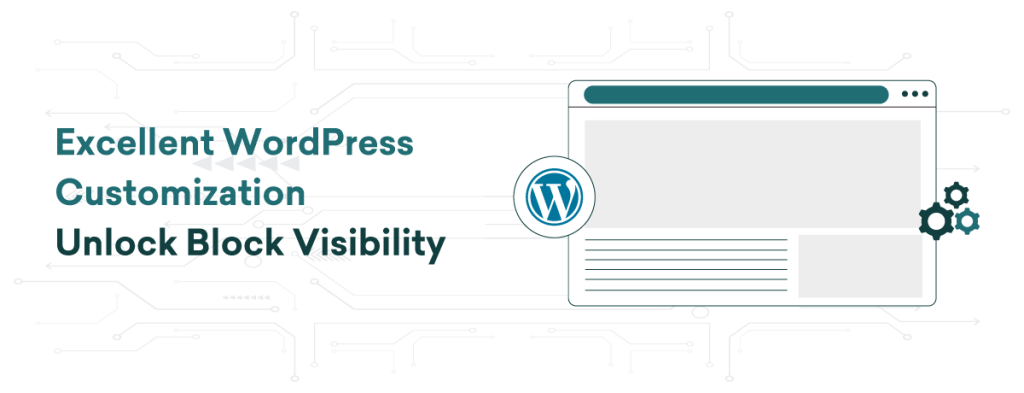How G Suite Can Help You Grow Your Business
Would you like to improve your website’s user experience with complete control over your content? If yes, then you’re in for a treat! The Block Visibility plugin is a game-changer that simplifies customization and eliminates the need for multiple plugins to tweak visibility settings.
This plugin empowers you with full control over your WordPress Hosting site through its user-friendly interface and unparalleled control features. In this article, we’ll dive into the numerous benefits of Block Visibility, from its easy-to-use interface to how it can transform your content creation experience.
By the end of this article, you’ll be equipped with the knowledge to enhance your posts and manage your content like a professional. Let’s explore together and unlock the full potential of your website!
Introduction of Block Visibility
Block Visibility is a useful WordPress plugin that enhances the functionality of the block editor. It offers users more control and visibility over their content, including various elements provided by WordPress and third-party additions. Moreover, it extends to block-based widgets and even works with the Full Site Editor.
One of the most noteworthy features of Block Visibility is its ability to manage both native and third-party blocks. For instance, third-party blocks could be embedded widgets, adverts, or analytics tools offered by third-party vendors or platforms.
With Block Visibility, you can manage the display of your content based on various control conditions. These conditions include user roles, login status, device kinds, referrer URLs, geographical zones, and more.
Using the role control conditions, you can personalize messaging and display conditional blocks for specific audiences. Additionally, website owners can schedule blocks to appear or disappear at certain intervals.
Key Features
Visibility Controls:-
Display Blocks Based On Certain User Roles: This feature allows for the customization of content visibility on a webpage based on users’ assigned roles. For example, administrators would have access to backend controls and settings, while subscribers would see exclusive content related to their subscriptions. Customers, on the other hand, would view product-related information, and members would access content tailored to their membership.
Use Post And User Metadata To Specify Visibility Conditions: This functionality lets you establish criteria based on post and user metadata. Metadata refers to supplementary information associated with posts (such as articles or pages) and users on your website. It may contain custom fields that provide more detailed information about the content or users. For instance, you can opt to show a promotional block only on posts marked as “technology” or “fashion.” This ensures that the promotion reaches the most appropriate audience.
Display Blocks Based On A Visitor’s Referral Source: When a person visits your website, they may arrive there by clicking a link from another site. Therefore, you can manage what they see on your website based on the domain or URL they clicked to get there. For instance, if a visitor reaches your online bookstore through a link shared on a book review website, you could display a personalized recommendation block highlighting books that are similar to those reviewed on the referring site.
Schedule When Content Should Be Visible: You can set specific start and end dates/times for seasonal content visibility. This feature allows you to have control over when certain blocks appear on your website. For example, you can schedule a block advertising winter ski packages to appear from November to March and then switch to promoting summer activities during the other months. This can help you better tailor your website’s content to the current season and keep it up-to-date.
Show Or Hide Dynamic Blocks Based On URL Query Strings: You have the option to show or hide website blocks depending on the URL query parameters. URL parameters can be used to monitor the effectiveness of your marketing campaigns. For example, if a visitor clicks on a campaign link that promotes a summer sale, you can use dynamic blocks to display relevant products based on the parameters within the URL. This method is different from displaying blocks based on referral sources since it allows for more accurate customization linked to specific campaign details within the URL.
Hide Blocks From All Users: You can completely hide specific blocks of content from being visible to any visitor on your website. This means that the content you have chosen to hide will not be visible to anyone. For instance, if you are in the process of redesigning your website’s homepage, you can hide certain sections until the updates are complete. This will prevent visitors from seeing incomplete content. Furthermore, you could also use this feature to hide private documents or confidential information that is not meant for public viewing.
Block Visibility Using HTML Cookies: HTTP cookies are small pieces of data that store information about a user’s browsing history, preferences, and other relevant data. These cookies can be used to manage blocks on your website based on the presence or absence of certain cookies in the user’s browser.
For example, if a user has previously visited a specific section of your website, you can use a cookie to remember their preference and display relevant content when they return.
Default Visibility Controls: By using default visibility controls, you can ensure that your website’s messaging is consistent across all pages. This feature allows you to establish a baseline visibility configuration for your content blocks, making it a convenient way to set up rules for displaying your content. For instance, you can set a default rule to always display a promotional banner site-wide, which guarantees that your visitors will see the offer regardless of the page they are on.
Integration With Third-Party Plugins:-
WooCommerce: The WooCommerce integration with block visibility allows you to manage content display based on essential e-commerce parameters such as purchase history and order status. An efficient way to enhance user experience, promote relevant products, and optimize conversions on your WooCommerce website is by blocking the content of specific products or categories. Additionally, you can customize content visibility based on control conditions, such as a user’s cart. This will help you to tailor the user experience to their preferences and needs.
Advanced Custom Fields (ACF): Advanced Custom Fields is a popular WordPress plugin that allows users to add custom fields to their WordPress websites. Adding ACF with block visibility enhances your flexibility options as a content creator or developer. Also, you can create custom fields and assign them to other content categories like posts, pages, and custom post types.
Easy Digital Downloads: Easy Digital Downloads (EDD) is a popular WordPress e-commerce plugin that enables the sale of digital products. Integrating EDD into your online store can enhance it by allowing you to display specific content based on EDD-specific rules. This makes it easier to target the right audience based on factors such as the digital products they have purchased, their shopping cart, purchase history, and current orders.
WP Fusion: WP Fusion is a plugin that facilitates the connection between WordPress websites and Customer Relationship Management (CRM) platforms such as Salesforce, HubSpot, or Keap. It synchronizes user information, e-commerce data, content engagement metrics, and segmentation tags between WordPress and CRM platforms seamlessly. WP Fusion offers the ability to personalize the visibility of content blocks based on user data stored in the CRM.
Other Features:-
WooCommerce: The WooCommerce integration with block visibility allows you to manage content display based on essential e-commerce parameters such as purchase history and order status. An efficient way to enhance user experience, promote relevant products, and optimize conversions on your WooCommerce website is by blocking the content of specific products or categories. Additionally, you can customize content visibility based on control conditions, such as a user’s cart. This will help you to tailor the user experience to their preferences and needs.
Advanced Custom Fields (ACF): Advanced Custom Fields is a popular WordPress plugin that allows users to add custom fields to their WordPress websites. Adding ACF with block visibility enhances your flexibility options as a content creator or developer. Also, you can create custom fields and assign them to other content categories like posts, pages, and custom post types.
Easy Digital Downloads: Easy Digital Downloads (EDD) is a popular WordPress e-commerce plugin that enables the sale of digital products. Integrating EDD into your online store can enhance it by allowing you to display specific content based on EDD-specific rules. This makes it easier to target the right audience based on factors such as the digital products they have purchased, their shopping cart, purchase history, and current orders.
WP Fusion: WP Fusion is a plugin that facilitates the connection between WordPress websites and Customer Relationship Management (CRM) platforms such as Salesforce, HubSpot, or Keap. It synchronizes user information, e-commerce data, content engagement metrics, and segmentation tags between WordPress and CRM platforms seamlessly. WP Fusion offers the ability to personalize the visibility of content blocks based on user data stored in the CRM.
Use of Block Visibility
Before diving into the details of using block visibility, it’s important to note a couple of options. Fortunately, they are quite simple.
Firstly, make sure that you have a WordPress site with the WordPress Site Editor installed.
Here are the steps you need to follow:
Step 1: Go to the toolbar menu and select “Plugins.”
Step 2: Click on “Add New Plugin.”
Step 3: In the keyword box at the top right, search for “Block Visibility.”
Step 4: Choose “Block Visibility – Conditional Visibility Control for the Block Editor by Nick Diego.”
Step 5: Click on the “Install Now” button.
Step 6: Once the installation is complete, click on the “Activate” button to enable the plugin on your WordPress site.
Use Block Visibility In A Post
To use block visibility in a post, follow these simple steps:
Step 1: Create a post and select a block.
Step 2: Scroll down to the block settings on the right-hand side of the screen and click on the Visibility option.
Step 3: For some blocks, you will see “Visibility Controls” under the block settings.
Step 4: Click on a specific condition and set a rule.
Step 5: Choose an option to manage your block’s visibility on the current post. For example, you can schedule the block to appear on a specific date.
Step 6: Once you have finished, make sure to click on Save Draft, Update, or Publish to save your progress. This will ensure that you don’t lose your work.
Benefits
Conditional block visibility provides several benefits, enabling you to quickly adapt and respond to changes in the market. Let’s take a closer look at them.
Targeted content: With conditional visibility controls, you can decide what visitors see and when content is displayed. This allows you to provide personalized content that is relevant to each user.
Ease of use: Block Visibility features an intuitive interface that does not require coding expertise. You can effortlessly control when and where blocks appear on your website without dealing with complex code or technical details.
User behavior adaptation: Block visibility can be configured to adapt to user behavior or preferences. This means that you can offer content based on a previous or current user’s interaction or demographics.
Improved user experience: Scheduling controls can be used to provide relevant content at the right time, resulting in a better user experience. This can increase engagement, improve user satisfaction and lead to higher customer retention rates.
Optimized page layout: By controlling the placement and timing of different content elements using time controls, you can manage the layout of your web pages. This helps avoid clutter and ensures that users are not overwhelmed with too much information.















